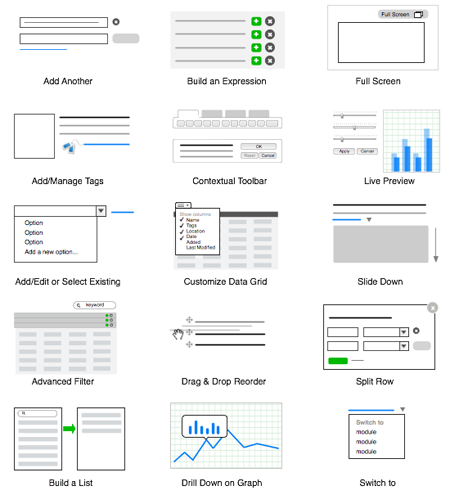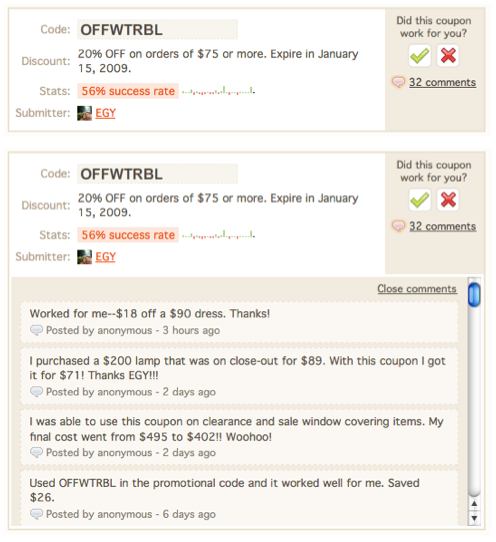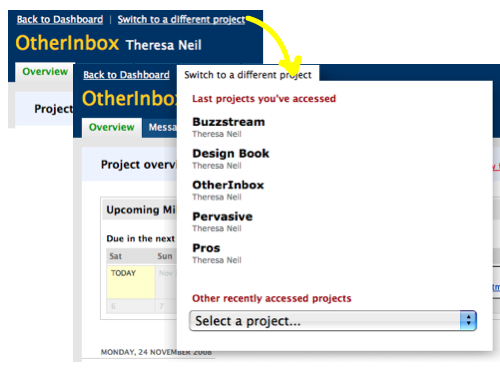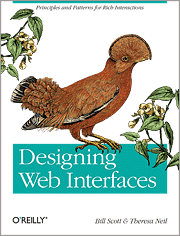15 Common Component Patterns
By Theresa Neil
As Bill mentioned in an earlier post, we don’t want to limit this blog to just the principles and patterns found in the book. For that you can check out our Explore the Book section.
This is the third article in a three part series on patterns and principles for RIA design.
- Standard Screen Patterns: 12 patterns w/100 examples
- Essential Controls: 30 controls for RIA design and development
- Common Component Patterns: 15 patterns and examples
Odds are good if you are designing a enterprise software or a productivity web application, you’ll need a number of these components. Don’t spend time and effort on (re)designing these ancillary features- try these solutions instead.

01. Add Another

Wufoo (button)

Gmail (link)
Requirement: Need to offer multiple input fields for the same thing, but unsure how many the user may need
Example: Add attachments, enter phone numbers, upload photos…
Description: The “add another” link or button should be in proximity to the field, and the remove option is shown an attachment is added, and only one “add another” link is shown at a time. No need to show the remove button until at least one entry is shown.
02. Add/Manage Tags

Highrise (inline edit)

Mint (dialog)
Requirement: Need a way to add non-structured meta data to an object that can later be searched
Example: While adding recruits to a CRM system, the recruiter wants to note applicants’ interests and hobbies
Description: Place the tags in close proximity to the object being taggged. Allow for direct adding of additional tags and editing. You can take the 37signals approach and let users type in any tags they want- running the risk of duplicate, misspelled or overlapping concept tags. Or use Mint’s approach and let users select from the existing list of tags, and/or add new ones.
03. Add/Edit or Select from Existing

Highrise
Requirement: Need to pick from an existing option, add a new option, or edit an existing option
Example: Recording receipts for household expenses, and there is not a category for pet/vet bills. Add a new category for “pets”, which will now show up as an option in the list
Description: Place the option for “add new…” at the bottom of the options. Open a new dialog or light weight layer to add the new option. Place edit to the right of the list box, edit can be a new screen or dialog for editing all the options.
04. Advanced Filter

Mission 360 for The Leukemia & Lymphoma Society
Requirement: Need to refine the data set based on specified criteria
Example: In a bug tracking system, a developer needs to see all bugs assigned to him, in the last 24 hours, related to the production system, containing the term “feedback”
Description: Provide a dynamic filter field and offer an advanced filter option, where the user can specify criteria for refining the data set. Allow the criteria to be saved (usually as a ‘view’), that can be accessed again. Note* Luke W. has a great article describing multiple techniques for refining data tables.
05. Build a List (aka Accumulator)

LinkedIn
Requirement:Need to create a list from an existing set of options
Example: Invite some of your friends from your existing list of webmail contacts, or build a list of hot prospects for a sales campaign
Description: When a user needs to select items from separate sets of search results or other large, unwieldy data sets- let them manipulate the left (search, sort, navigate or filter), and add to the right.
06. Build an Expression (aka Predicate Editor)

Wufoo

Mac OS predicate editor inspired web versions of this component
Requirement: Need to define a set of conditions that build on each other.
Example: Complex search or building a report filter, or building a mathematical function
Description: Design it so the expression can be read, left to right, top to bottom. Each line can be edited, removed, or deleted, and possibly rearranged in order.
07. Contextual Toolbar

Picnik
Requirement: Need to perform an action that has multiple input parameters
Example: Analyst needs to apply a discount to all the rows in a table, clicks the ‘discount’ tool. The discount options: discount percent [10%] or flat rate discount [$0.00], are then provided.
Description: Group the actions in a toolbar, and as one is selected, disclose the input parameters. Offer a live preview if applicable.
08. Customizable Data Grid
Requirement: Need robust data grid from viewing, editing and manipulating data
Example: A CRM system with contacts displayed in a table/data grid
Description: Offer simple and advanced filtering, ability to directly resize columns, ability to directly rearrange columns, hide/show columns, sorting. If also providing editing, provide a toolbar that includes undo and redo actions.
09. Drag & Drop Reorder

Basecamp

Cogmap
Requirement: Need to reorder a text list, visual map, or tree because the order is indicative of priority or hierarchical relationship
Example: To-do list, org chart, tree
Description: Make sure to follow the interaction principles for all the states of drag and drop management, most importantly providing a visual cue the list can be rearranged, like the drag handles in the examples. Refer to Bill’s Interesting Moments Grid for implementing the interaction properly.
10. Full Screen

Picnik

RadEditor Demo
Requirement: Need more real estate for core functionality
Example:Editing a photo, designing a work flow, navigating a map
Description: Place the toggle in the top left corner (make sure it remains in the same spot and visible even in the full screen mode). The branding and top level navigation can be hidden in this mode. Don’t add any more elements into the full screen mode- just enlarge the workspace.
11. Graph Drill Down

Wesabe

Dundas Charts
Requirement: Need to show a summary view and allow a quick and efficient drill down to view more details, instead of navigating deeper into the graph
Example: A specific datapoint has multiple sets of information available. The main graph could show sales volume by sales person over time, and the hover detail breaks it down by new versus existing clients
Description: Provide a visual indicator (like a dot) that hover details are available. Use a non-modal layer to display the next level of data.
12. Live Preview

Fidelity MyPlan

Mint Savings Finder
Requirement: Need provide live feedback on changing criteria
Example: Graphic designer altering the hue of a photo needs to see the effect as he adjust the value
Description: Provide easy to manipulate controls, and an “apply” and “cancel” options, or “revert” feature.
13. Slide Down

RetailMeNot.com (inline)

Weight Watchers (overlay)
Requirement: Need to show more details, or input details
Example: Reading an article in a list of articles, scan the first paragraph and want to read more, or read the comments.
Description: Expand inline or overlay without leaving the page or opening a new window/dialog. Use smooth transitions and a fixed height scroll window like RetailMeNot. Provide the close link in the same spot.
14. Split a Transaction

Mint
Requirement: Need to allocate a single item across multiple categroies
Example: Dividing a transaction (ex. allocating a 50% of a donation to one recipient, and 50% to another recipient, or $2.00 as a fee, and $200.00 as cash withdraw)
Description: Split button placed unobtrusively in the transaction detail pane, could also be a tool in the table toolbar, enabled when a row is selected. Opens a dialog allowing the user to re-allocate the data as needed.
15. Switch To

Basecamp

Zoho
Requirement: Need to infrequently navigate out of one module into another without returning to a control panel, dashboard or dock
Example: Working in one project, finish and need to work on another one
Description: Make the switch less visually prominent than the main navigation, but still easily accessible (top right or left, above the main menu).


GeekyCoder Said,
February 11, 2009 @ 1:23 pm
Hi,
I like to offer another example for Add/Manage Tags which I have used in my own application which can be added to your list.
This is basically just a TextArea box that allow user to enter a tag per line. Above the textArea box, there will be a instruction label telling user to enter the tag in which line, and beside also Sort Button, which allow user to sort by alphabet.
The advantage of this is the flexibility of freeform adding, editing and deleting tags. It also allow drag and drop of selection within the textarea
(Note: I have previously entered this comment in previous post of yours which should be removed)
Methink.com - Ruby on Rails Web Development & Consulting: UI Design Patterns « Said,
February 18, 2009 @ 5:44 pm
[...] Â Â - 15 Common Component Patterns [...]
Web Design Interfaces | Herbert Mühlburger's Weblog Said,
February 23, 2009 @ 12:48 am
[...] The first one deales with 30 essential controls used in web interfaces. The second one descirbes 15 common components used in web user interface [...]
Mahbub Said,
April 18, 2009 @ 11:23 pm
I specifically like the add another part because some people just demand unfeasible solutions following no standard. I’ve been using like the one u pointed. Nice work though.
Topics about Web-design | 15 Common Component Patterns Said,
April 25, 2009 @ 7:47 am
[...] Videos de Cuates created an interesting post today on 15 Common Component PatternsHere’s a short outline Bookmark this on Delicious – Saved by vincentgates to webdesign design css interface ui designpatterns – More about this bookmark [...]
MR. Book Editor Said,
June 2, 2009 @ 3:07 pm
Hi, Nice of you to confuse us with the term RIA.
Are we supposed to hunt for that meaning right from the start of the article?
Gabriel Said,
June 15, 2009 @ 6:04 pm
@ Mr. Book Editor – I believe you meant to say acronym instead of term. And the acronym stands for Rich Internet Application(s). This is not a new concept by any means. Troll.
Twitted by RobDiMaggio Said,
August 16, 2009 @ 8:49 am
[...] This post was Twitted by RobDiMaggio [...]
Twitted by dernilson Said,
August 16, 2009 @ 9:24 am
[...] This post was Twitted by dernilson [...]
15 Common Component Patterns Said,
August 16, 2009 @ 9:37 am
[...] Link: 15 Common Component Patterns [...]
Twitter Trackbacks for 15 Common Component Patterns [designingwebinterfaces.com] on Topsy.com Said,
September 1, 2009 @ 7:48 am
[...] 15 Common Component Patterns designingwebinterfaces.com/15-common-components – view page – cached how to treat Herpes labialis online order clomid drugstore women’s health buy acyclovir online pet meds online free avi download movies hdtv torrent — From the page [...]
baluoct23 Said,
October 22, 2009 @ 7:56 pm
Thanks…. good post, useful information for Patterns.
15 Common Component Patterns » Web Design Said,
January 26, 2010 @ 12:20 am
[...] 15 Common Component Patterns [...]
15 Common Component Patterns « Netcrema – creme de la social news via digg + delicious + stumpleupon + reddit Said,
January 26, 2010 @ 1:36 am
[...] 15 Common Component Patternsdesigningwebinterfaces.com [...]
15 Common Component Patterns : Popular Links : eConsultant Said,
January 26, 2010 @ 5:53 am
[...] here: 15 Common Component Patterns 9 February 2009 | Uncategorized | Trackback | del.icio.us | Stumble it! | View Count : 0 Next [...]
SMiGL Said,
January 27, 2010 @ 2:55 am
Good collection. Thanks
links for 2010-01-27 « Köszönjük, Emese! Said,
January 27, 2010 @ 3:39 am
[...] 15 Common Component Patterns Odds are good if you are designing a enterprise software or a productivity web application, you’ll need a number of these components. Don’t spend time and effort on (re)designing these ancillary features- try these solutions instead. (tags: webdesign patterns ui) [...]
Meine neusten Bookmarks von 15.26.2010 bis 17.30.2010 | knalleffekt.ch - ein Usability, Web 2.0 & User Centered Design Blog Said,
January 30, 2010 @ 9:38 am
[...] 15 Common Component Patterns – Drucken, versenden und teilen: [...]
Chicago Web Design Said,
March 8, 2010 @ 9:18 am
fantastic post! Its always great to have a one stop shop for the simple stuff in case you forget.
uberVU - social comments Said,
March 26, 2010 @ 6:37 am
Social comments and analytics for this post…
This post was mentioned on Twitter by SC_Stephenson: RT @RobStajo Use these patterns if you want to design a good web interface: 15 Common Component Patterns http://is.gd/jy40 @myEN #design…
chicago web developer Said,
April 12, 2010 @ 5:05 am
Great post. Thanks for all these magic solution. They work wonders. You might like to see my portfolio here chicago web developer. Any feedback would be welcome.
Free I Share åˆ†äº«èµ„æº åˆ†äº«å¿«ä¹ » Blog Archive » 12 Standard Screen Patterns Said,
April 17, 2010 @ 8:12 pm
[...] Components for Commonly Requested Features: 15 patterns and examples [...]
12ä¸ªæ ‡å‡†å±å¹•è®¾è®¡æ¨¡å¼ | DeanYan.com Said,
December 4, 2010 @ 9:14 pm
[...] 通用需求特性组件:15个模å¼å’Œç¤ºä¾‹ [...]